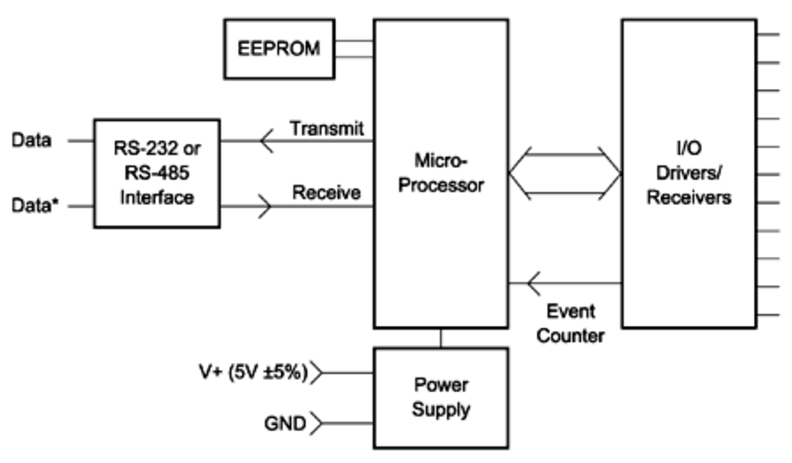SCM9B-H1750/H1770
24 & 64-Channel Digital I/O Boards
The SCM9B-H1750/H1770 digital I/O interface is designed to expand the remote I/O capability of the SCM9B-1700 series of modules. Commands are communicated over RS-232 or RS-485 links from any standard serial I/O port of computers or modems. The command set for the H1700 series boards is identical to the 1700 series modules.
The H1750 is designed to interface directly to either a 16- or 24-channel industry-standard solid-state relay rack (Dataforth part numbers SCMD-PB16 or SCMD-PB24). The H1770 will connect to a maximum of four 16-channel racks (SCMD-PB16). As with the SCM9B modules, up to 124 boards can be multidropped using RS-485 communications and SCM9B-A1000 repeaters.
The I/O channels may be configured to be inputs or outputs in any combination designated by the user. The input/output configuration may be changed at any time through the communications port. The I/O assignments are saved in nonvolatile memory and are automatically loaded when the unit is powered up. All boards are supplied with screw terminal plugs or ribbon connectors and captive mounting hardware.
The H1750 is designed to interface directly to either a 16- or 24-channel industry-standard solid-state relay rack (Dataforth part numbers SCMD-PB16 or SCMD-PB24). The H1770 will connect to a maximum of four 16-channel racks (SCMD-PB16). As with the SCM9B modules, up to 124 boards can be multidropped using RS-485 communications and SCM9B-A1000 repeaters.
The I/O channels may be configured to be inputs or outputs in any combination designated by the user. The input/output configuration may be changed at any time through the communications port. The I/O assignments are saved in nonvolatile memory and are automatically loaded when the unit is powered up. All boards are supplied with screw terminal plugs or ribbon connectors and captive mounting hardware.
Certifications

Documents
Product Availability
Usually stock to 2-3 weeks
Dimensions & Accessories
Features
- Computer Monitoring and Control of Standard Digital I/O Modules via RS-232 or RS-485
- Digital Inputs and Outputs Interface with Solid State Relays to Sense AC and DC Voltages
- Controls Digital Inputs and Outputs Individually
- User Can Define Any Bit as Input or Output
- 24- and 64-Channel Versions
- Expands up to 7936 Digital I/O Channels (124 Multidropped 64-Channel Boards)
- Read or Set 7936 Inputs or Outputs in Less Than 1s
- Mounts in 19" Racks
- Compatible with All SCM9B Products
- Same Command Set as 1700 Series Modules
- CE Compliant
Block Diagram

Ordering
NOTE: Data in below table can be filtered. Please use the
to make your selection. If you have any questions about the displayed data,
please contact Customer Service at +1 520-741-1404 or sales@dataforth.com
FAQ
Due to resource constraints on my computer, I'm unable to open the three dimensional CAD models provided on your website. Does Dataforth provide two demensional CAD models for download as well?
Two dimensional CAD models can be generated upon customer request. Please contact Customer Service for assistance.
How does the load resistance of a module affect the noise at the output?
Noise at the output of a module is independent of load resistance.
How do I convert an RMS voltage to its corresponding peak voltage?
To convert an RMS voltage to its corresponding peak voltage, you simply take the RMS voltage value and multiply it by the square root of 2, or roughly 1.414.
For example, 1500Vrms corresponds to a peak voltage of 1500 * 1.414 = 2121 Vp
If the input range of my signal conditioner is -1V to +1V and the output range is 0 to 10V, does this mean that it ignores polarity?
A signal conditioner with these I/O ranges does not mean that the module ignores the polarity of your voltage input. The output of voltage input modules are scaled linearly, meaning an input of -1V would correspond to an output of 0V, an input of 0V would correspond to an output of 5V, an input of +1V would correspond to an output of 10V, and so on.
Analog Devices announced a last time buy and discontinuance of their signal conditioning modules. Can I replace them with Dataforth signal conditioning modules?
Yes, in general, Dataforth signal conditioning modules are a direct replacement for all Analog Devices signal conditioning modules. e.g. "SCM5B35-xx: Linearized 4-Wire RTD Input Modules" will replace Analog Devices "5B35: Isolated 4 Wire RTD Input Signal Conditioning Module".
Please note that Dataforth signal conditioning modules are RoHS II compliant.
Can Dataforth provide calibration reports for modules I purchased?
Yes we can provide calibration reports for the modules that you purchased.
You can either
a) visit https://www.dataforth.com/TestDataReport.aspx to search for Test Report Datasheets by Serial Number or
b) you can send us a list of model numbers and their serial numbers to support@dataforth.com
Custom Modules
Below is a list of existing custom modules. If you don't see a module matching your target specifications, contact Customer Service and Application Support to discuss design guidelines and
design feasibility. Customer Service and Application Support can be reached at
sales@dataforth.com or +1-800-444-7644.
NOTE: Data in below table can be filtered. Please use the
to make your selection. If you have any questions about the displayed data,
please contact Customer Service at +1 520-741-1404 or sales@dataforth.com
* ... Status Codes: PR = Production, PT = Prototypes, QU = Quoted
We want your feedback!
We are interested in your feedback regarding our products. Please let us know what you think and if you have any questions regarding the SCM5B32 and how this product could apply to your application. Your feedback is very valuable to us and very much appreciated.
Was this content helpful?
Thank you for your feedback!






